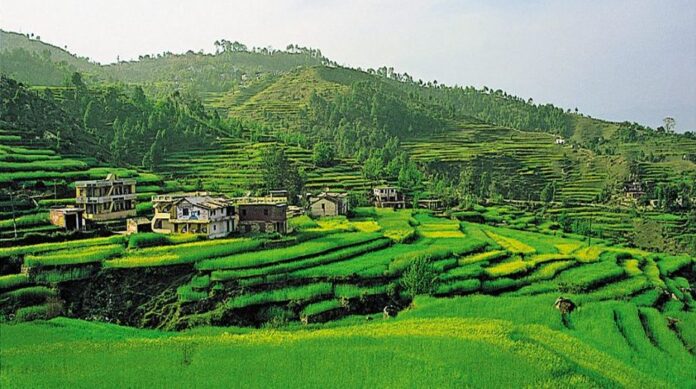Mahatma Gandhi went to Kausani in 1929 for attending a political campaign. It is said that the mountain ranges mesmerised him so much that he absolved himself from his daily activities and took to meditation. He originally went for two or three days but ended up staying there at the government Dak Bungalow for 12 days! Gandhi ji put off his hectic schedule and started writing on Anasakti Yoga, which is mentioned in the Bhagavad Gita. He said Kausani is “the Switzerland of India”. After that, the government Dak Bungalow was converted into Anasakti Ashram, popularly known as the Gandhi Ashram of Kausani in Uttarakhand.
In the morning, when I set out for Kausani from Almora, white clouds wafted over the deep valley and the warm sunshine brightened the serpentine road ahead, which went past coniferous forests. Each bend gave way to pleasing sights and the snowcapped mountain ranges played hide and seek with us. After a two-and-half-hour ride, I halted before the old Someshwar Temple, which was a treat to the eyes after a tiresome journey. Leaving behind a small market to the left, the car winded up another 1,000 ft to reach the Anasakti Ashram.
I rushed, with excitement, to the view point in front of the CCCCCCCPrayer Hall. It seemed as if the vast blue sky was well within our reach! On the other side valleys, cut into steps for cultivation descended deep down. One was left spellbound by the serenity of the place surrounded by tall pine trees. I felt enthralled to live in the century-old heritage building where once Gandhi and other stalwarts had set foot and the walls of the Prayer Hall exhibit rare photographs on the life of Mahatma Gandhi.
After a delicious lunch and a stroll in the nearby market, I started for Baijnath, which is 19 km away from Kausani. The road was hemmed in by thick oak, fir and pine trees. Paddy fields were down below and the driver informed that the Basmati rice grown here is exported to foreign countries. The road to the temple goes over the Gomti River. Once there, one was witness to the magnificent twelve stone temples complex of Ek rekha deula or single-shrine structures, dedicated to Lord Baijanath or Shiva, Parvati, Ganesha, Brahma and Chandika, by the Gomti. They were built by the Katyuri rulers around the 13th century but subsequent invasions by Tamerlane, followed by Nadir Shah, left its architectural glory devastated. It was saddening to see such heritage temples left neglected without proper maintenance.
On the way back, I made a beeline for the workshops where the famous Kausani shawls are manufactured. It is said that Kausani was discovered in the early 20th century by the Troupe brothers who tried their hands at tea cultivation on the slopes of Kausani and also erected a bungalow there, which is now a coveted rest stop for mountaineers and expedition teams heading towards Manas Sarovar.
Next morning, a huge crowd had gathered to see the sun bathe the Himalayas in all its resplendent glory. One was elated to spot the different snow-clad peaks like Nanda Devi, Kamet, Trisul, Chaukhamba, Hati-Ghori, Nilkantha and Panchachuli among others, standing like walls as high as 22,000ft and stretching over 300km. The beaming sunshine behind the ranges made it look like a divine halo and the peaks seemed to vie with each other to be the first one to bathe in the sun rays. Within a matter of seconds, I witnessed a magical sight as the white peaks turned fiery red.
The last destination on the tour was Ranikhet where one was greeted with the white ranges almost touching the sky. As I said goodbye, memories of staying in the same place as the Father of the Nation with the Himalayas in the background filled the mind.


